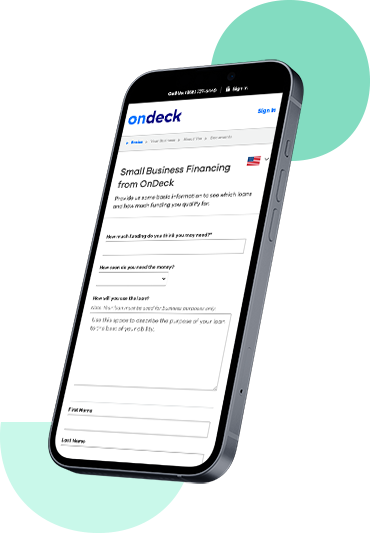Medical Practice Loans
Learn about financing options for doctors, dentists, veterinarians and other healthcare professionals.


TrustScore 4.6 | 4674 reviews

Find the right loan for your medical practice.
Running a medical practice comes with unique financial needs. You may want to start a new practice, buy medical equipment or cover cash flow gaps while you’re waiting for the insurance companies to pay.
Financial concerns can be a burden and they may stop you from doing everything you want to do for your patients. Medical practice loans can provide you with the funds you need so you can get back to taking care of people.
Medical practice financing from OnDeck.
OnDeck Line of Credit
A revolving credit line you can draw from 24/7 to receive funds within seconds.*
- Credit limits from $6K - $200K
- Flexible repayment terms of 12, 18 or 24 months
- Great for ongoing cash flow needs
OnDeck Term Loan
A one-time lump sum of cash with an eventual option to apply for more.
- Loan amounts from $5K - $250K
- Repayment terms up to 24 months
- Great for one-time investments in your business
Common types of medical practice loans.
Business Line of Credit
A business line of credit is a form of revolving credit. It’s good for covering cash flow gaps or taking care of ongoing expenses. Approved health care providers will get a set credit limit they can draw funds from. The funds are deposited into a business bank account and from there can be used like cash. The borrower will only pay interest on what they borrow, and as the funds are repaid, they become available to borrow again.
Equipment Financing
Equipment financing can refer to equipment loans or equipment leasing. With an equipment loan, the small business owner will receive a lump sum of cash to purchase equipment, such as an X-ray machine. The newly purchased equipment then acts as collateral for the loan. If you decide to lease equipment, the lender will purchase the equipment and allow you to rent it out. You may have the option of buying the equipment when the lease is up. OnDeck products can be used as equipment loans, but we do not offer equipment leasing.
Business Term Loan
A business term loan can provide medical practitioners with an upfront lump sum of cash. This can be helpful when faced with large one-time expenses. If approved, the financing will be deposited into a business bank account, where it can be used to cover costs. The funds are repaid over a set period of time. These can be short-term loans that will be paid back in a few months or long-term loans.
Invoice Factoring
Invoice factoring is a type of financing where a company can sell their unpaid invoices for a percentage of their value. The invoice factoring company that buys the invoices will pay a portion of the agreed price when they purchase the invoices, and the rest of the money after they’ve collected payment from your customers. This allows small business owners to receive funds immediately instead of waiting for the invoices to be paid. OnDeck does not offer invoice factoring.
Where can I find business loans for healthcare professionals?
Bank
When people think about getting financing for their medical office, they tend to think of traditional lenders like banks. Bank loans can provide the funds you need, but the application process can be long, and getting approved may be difficult.
Online Lender
Online lenders, like OnDeck, are a popular option for many small business owners, including medical professionals. These alternative lenders often have less strict approval requirements and the application and funding process is fast and easy.
SBA loan guarantee program
The Small Business Administration (SBA) offers guarantees on business loans provided by traditional banks and credit unions. These types of loans often have lower interest rates but getting approved can be a long and difficult process.
We’re fluent in small business — and ready to take your call.
You don’t need to be an expert on small business loans. Our team of
(888) 269-4246
Monday – Friday
9 a.m. – 7:30 p.m. ET

Business funding that moves at your speed.
-
Step 1
Complete the application.
Our streamlined process is designed to be completed in just minutes.
-
Step 2
Get a decision.
We’ll let you know if you qualify for our term loan, line of credit or both. If approved, you can then choose your loan amount and repayment terms.
-
Step 3
Receive your funds.
Sign your contract and get funds as soon as the same day.†

Learn more about medical practice loans.
Medical practice loans work similarly to other business loans, though they may be subject to some further review. For instance, a medical lender may ask to see your license and some documentation on the type of medical business you run.
Medical practice loans can be used to help you start or grow a medical practice.
Startup costs. If you want to start a new practice or start a new location for your existing practice, there are loan options available to help you do everything from purchasing commercial real estate to advertising your new medical business.
Equipment purchases. Medical equipment can be very expensive. You may not be able to cover the costs with your business credit card. Instead, you may want to use a medical practice loan to cover the cost of new equipment.
Working capital. Many health care practices bill on invoices, meaning you won't get paid right away. There are health care financing options that can help you cover the day-to-day costs of running your practice.
Medical practice financing is intended to help you run or grow your medical practice, but you have a lot of room to decide how it is used. While lenders may ask for verification when you apply for the loan, you have flexibility in how you use the money for your business.
Keep in mind that any kind of business financing is only intended to be used for business purposes. If you use the money for personal expenses, you could get into trouble with the IRS. Be sure to keep receipts showing how the money was used.
Medical practice financing can be used by all sorts of medical and wellness businesses. This includes:
- Physicians.
- Psychologists.
- Optometrists.
- Dentists.
- Chiropractors.
- Nurse practitioners.
- Wellness professionals such as Reiki professionals.
In order to get a medical practice loan, there are a few steps you need to take.
Review your business finances. Before applying for financing, you should take a look at where you stand financially. Consider what type of loan payments you can reasonably afford and if the cost of financing outweighs the benefits.
Research lenders. If you decide to move forward, you'll need to research lenders. Look for lenders that offer financing options that fit your needs. You also need to ensure that you meet their lending requirements. Some lenders will have requirements such as a minimum credit score, time in business and annual revenue.
Organize your documents. You'll likely need to submit a few different types of documents when you apply for a business loan. This can include financial documentation like bank statements, tax returns and balance sheets. Lenders may also ask to see proof of ownership, a business license and an ID or Social Security number.
Submit a loan application. Depending on the lender you choose, the application process may look different. With online lenders, you can fill out an application online, upload the documents and submit your application. Banks, credit unions and other financial institutions may have a more in-depth application process.